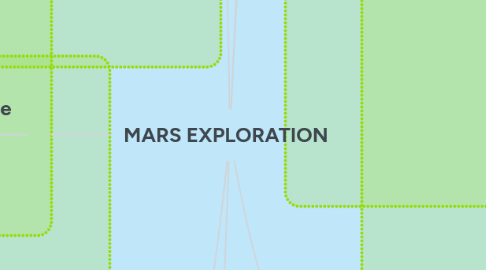
1. Goals/ Benifits
1.1. Explore the universe
1.2. Look for biosignatures, signs
1.2.1. Determine whether life existed on Mars
1.3. Characterize the climate of Mars
1.4. Learn about momentous shifts in climate that can fundamentally alter plantes
1.5. Characterize the age and composition of rocks on the Mars surface
1.6. Explore the possibility of immigration
1.6.1. Prepare for the immigration to Mars of the entire humanity
1.7. Development of new technology
1.7.1. eg, artificial limbs, solar cells, water filtration
1.8. Help to understand the origin of life
1.9. Explore for potential commercial value
2. Introduction/ Background
2.1. History
2.1.1. 1965, Mariner 4, the first timethat successfull flyby the Mars
2.1.2. 1971, Mars 3 is the first sapcecraft landed on Mars successful
2.1.3. Viking 1&2 landed and detected that living organisms as a negative result
2.1.4. 1996~2016,many spacecrafts landed on Mars andconductedvariousexperiment
2.1.4.1. 1997, Mars Pathfinder measured the rock andsoil, also include the statistics of Mar'sweather and dust
2.1.4.2. 2012, Curiosity investigated the water-and wind-formed strata and landforms near its landing site
2.1.4.3. 2014, Mars Orbiter Mission measured the hydrogen, deuterium, methane and other gases
2.1.5. 2018, Insight will do the seismic waves measurement and establish the effect of interior structure on the roatation of Mars
2.2. Why
2.2.1. Average temperature: -28 degrees Celsius (245K)
2.2.1.1. c
3. Companies/ Organizations Involed
3.1. NASA (National Aeronautics and Space Administration)
3.2. SpaceX
3.3. CNSA (China National Space Administration)
3.4. Roscosmos
4. Procedure
4.1. 1. launch the rocket
4.2. 2.when it arrive to the Mars, the cruise stage would separates
4.3. 3.Launch the rover and enters the martian atomsphere
4.4. 4. after pass through the martian atmosphere, then use the parachute to decrease the velocity of the rover and land
4.5. 5. collect data and sent it back to the earth
5. Science Subject Involed
5.1. Biology
5.1.1. Study on habitability (Yung et al., 2018)
5.2. Physics
5.2.1. Study on the solar radiation data on Mars that helps to design future missions
5.3. Astronomy and Planetary Science
5.3.1. Opposition: occurred when the configuration of the Sun, Earth, and Mars located in an approximately straight line. (Horton & Joyner, 2020)
5.4. Geology and Ecology
5.4.1. Composition of the materials on Mars surface (rocks, soil, minerals, etc.)
5.5. Mechanical Engineering /Robotics
5.5.1. Design and manufacture of the rovers
5.5.2. Design and manufacture of the spacecrafts
5.6. Aerospace engineering
5.6.1. Design and manufacture of the rockets
5.6.2. Design rockets propulsions and launching process
5.7. Astrobiology
5.7.1. Find some minerals formed by water at around 3.6 billions years ago
5.7.1.1. To determine were there have life before
5.8. Chemistry
5.8.1. Analyze the chemical properties (e.g. pH, salinity) of the substances on Mars surface
5.8.2. Analyze the elements on Mars
6. Problem Encountered/ to be Faced
6.1. Environment Challenges
6.1.1. Challenge of building structures on mars
6.1.2. Mars dust and dust storms
6.2. Physical Challenges
6.2.1. Change of gravity/ atmosphere
6.2.2. Hard work to stay alive for a long time
6.2.3. Adapting to the climate
6.3. Travel Challenges
6.3.1. Distance
6.3.2. Fuel consumption
6.3.3. Time it takes
6.3.4. Communication relay from earth
6.4. Orbital Challenges
6.4.1. Hazards of exposure to cosmic radiation
6.5. Planetary Challenges
6.5.1. Construction of Mars base
6.5.2. Identifying landing zone
7. Vehicles and Machine
7.1. Mars rovers
7.1.1. Curiosity (USA), launched at 26 Nov 2011, landed at 6 Aug 2012
7.1.2. Perservance (USA), launched at 30 Jul 2020, landed at 18 Feb 2021
7.2. Spacecrafts
7.2.1. Mariner 4 (USA), launched at 28 Nov 1964
7.2.1.1. Captured the first image of Mars
7.2.2. Mars 3 (Soviet Union), launched at 28 May 1971
7.2.2.1. The first spacecraft to soft land on Mars
7.2.3. Viking 1 (USA), launched at 20 Aug 1975
7.2.3.1. First image transmitted from the surface of Mars to Earth

